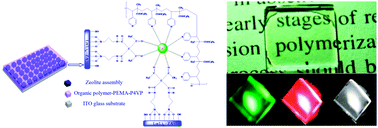Hybrid polymer thin films with a lanthanide–zeolite A host–guest system: coordination bonding assembly and photo-integration†
Abstract
A series of novel polymer–lanthanide–zeolite A hybrid films have been synthesized by polymerization of ethyl methacrylate (EMA) and 4-vinylpyridine (4VP) containing surface modified zeolite A, inside the channels of which lanthanide complexes are incorporated. The surface modification was conducted by first functionalizing zeolite A with a multi-functional linker and then covalently grafting lanthanide ions which coordinate to both the molecular linker and the polymer chain. The SEM images suggest that lanthanide-based zeolite A particles are evenly dispersed in the polymer matrices, leading to a certain transparency of the thin films. The luminescence properties of the resulting materials were characterized in detail and the results reveal that all the materials exhibit intense emission lines upon UV-light irradiation. Various emitting colors of the zeolite A–polymer materials can be obtained by simply changing the lanthanide complexes inside and outside the channels of zeolite A. Furthermore, the white light emission from the tricolor luminous materials can be easily obtained by adjusting the different concentrations of the doped ions and the excitation wavelength.


 Please wait while we load your content...
Please wait while we load your content...